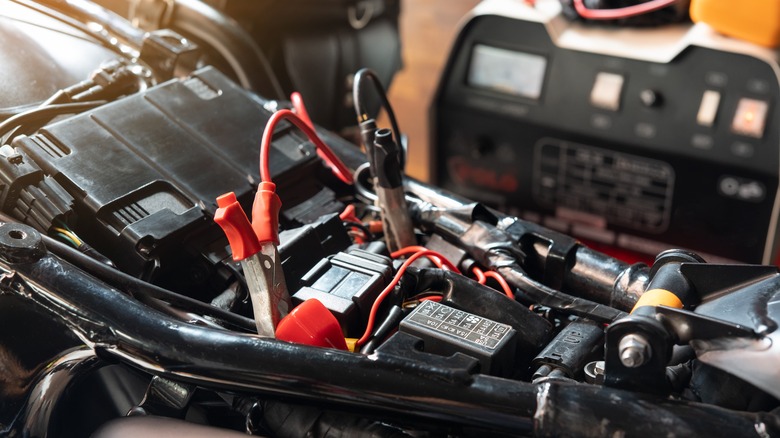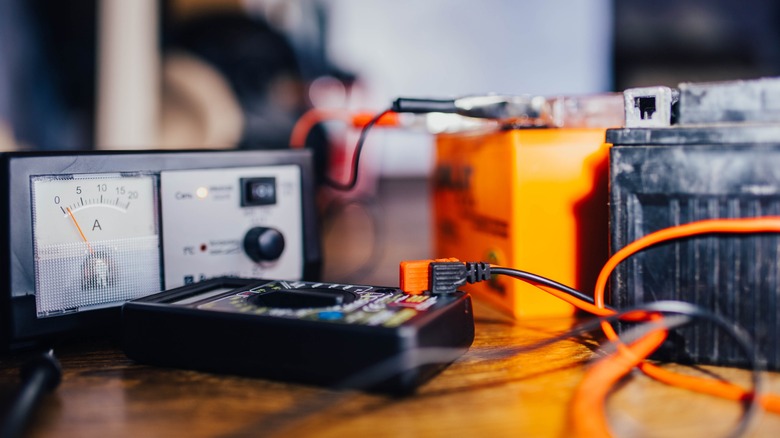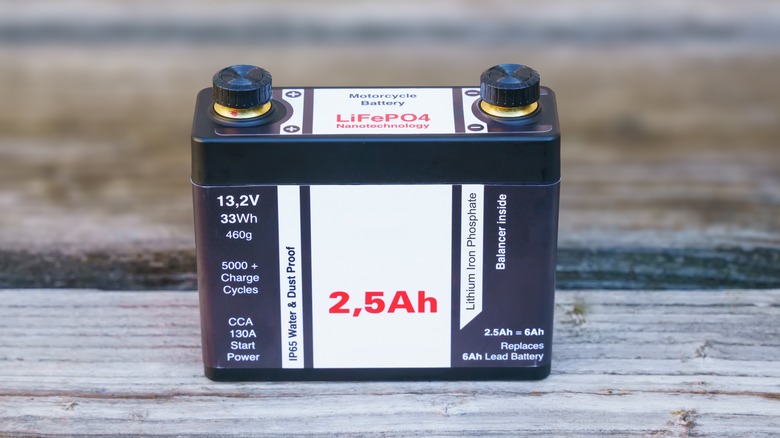
kasarp studio/Shutterstock
Have you spared a thought lately to the battery in your motorcycle? No, we’re not talking about wholly battery-powered motorcycles, just the regular gas-powered ones. Just like in a car, your motorcycle has an attached battery pack, which is used to trigger the engine startup and activate its onboard systems like lights, gauges, and displays. Depending on how fancy your bike is, the battery may not seem as important as it would on other kinds of vehicles, certainly not something that would require any particularly in-depth thought.
If you do take a moment to consider your motorcycle’s battery, though, you may find a previously unseen avenue of vehicular optimization. For example, do you know if your bike has an AGM or lithium battery installed? It may seem like an arbitrary distinction at a casual glance, but these two types of battery packs can have subtle effects on your motorcycle’s overall performance and longevity. If you’re interested in motorcycle customization at all, it would certainly behoove you to know the physical differences between these two battery pack types and what they each bring to the table.
AGM batteries are traditional lead-acid batteries, while lithium batteries use lithium iron phosphate

Velimir Zeland/Shutterstock
All vehicular batteries have the same purpose: using a combination of minerals and chemicals to store electricity long-term and funnel said electricity into the vehicle’s electronic components. In the specific case of AGM versus lithium, the difference is in the composition.
Absorbed glass mat batteries, or AGM for short, are more in line with the traditional paradigm of battery power. These sealed packs contain two sheets of lead, separated by a glass mat and floating in a pool of sulfuric acid. The glass mat helps to absorb and spread the energy generated by the positive and negative lead panels, ensuring an even distribution of energy without letting any of the fluid leak out.
Meanwhile, a lithium battery, as the name implies, swaps out those lead panels for a lithium iron phosphate construction. When the battery receives an electrical charge, electrons are generated from the lithium compound, which fly across a pool of specialized conductive solution to a slab of graphite on the other end.
It’s a lot of miscellaneous science, but the short version is that the way these two batteries are built and operate result in differences in operation, resilience, and power delivery.
AGM batteries are simple and reliable, but lithium batteries are becoming the dominant format

Sahara Prince/Shutterstock
AGM batteries have been a vehicular standard for decades, and for good reason: they’re hearty and reliable. Their sealed designs make them more resistant to the kind of intense vibrational force you may expect from a motorcycle, and they don’t usually need much in the way of recharging or maintenance. AGM batteries are especially good at enduring harsh environmental conditions like intense heat or cold, again thanks to their fully sealed bodies preventing warping and leaking.
On the other hand, lithium batteries are the big up-and-comer in the portable power scene, both in vehicles and in disposable batteries. One major upshot is that, since lithium is exponentially lighter than lead, lithium batteries are much lighter in weight than AGM batteries, which can be good for your motorcycle’s handling ability. Lithium can also carry a larger charge in a smaller package, which is good for vehicles with more complex auto-start systems built-in. The use of lithium is generally considered to be more environmentally friendly than lead, which can be a hazardous substance to humans.
Just about any motorcycle can be fit with either an AGM or lithium battery, provided you haven’t made any extensive modifications to the power system, though an older bike may require some additional components to make the fit properly. Both AGM and lithium batteries are available for competitive prices from most major brands, though as lithium technology continues to improve and AGM is phased out, the price factor may start to tip more in its favor.